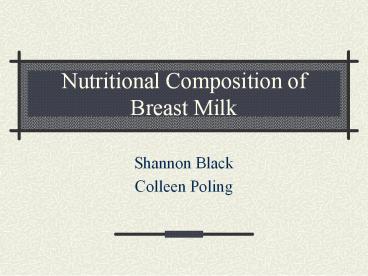Nutritional Composition of Breast Milk - PowerPoint PPT Presentation
Title:
Nutritional Composition of Breast Milk
Description:
Nutritional Composition of Breast Milk Shannon Black Colleen Poling ... pesticides. Environmental Exposures Not routinely checked for environmental exposures. – PowerPoint PPT presentation
Number of Views:1641
Avg rating:3.0/5.0
Title: Nutritional Composition of Breast Milk
1
Nutritional Composition of Breast Milk
- Shannon Black
- Colleen Poling
2
Human Milk Facts
- Isotonic Solution
- milk and plasma are of similar ion concentration
- Designed to protect infants chronic childhood
diseases. - T-lymphocytes, B-lymphocytes, neutrophils,
macrophages and epithelial cells aid in
protection - Two forms of breast milk are colostrum and mature
milk.
3
Lactogenesis
- Lactogenesis is the production of human milk.
- Three phases
- Lactogenesis I, II, III
4
Colostrum in Human Milk
- Thick, yellow fluid
- Produced during lactogenesis II (2-3 days after
birth) - Provides 58-70 cal/100 ml
- High in protein, electrolytes, sodium, potassium,
chloride and vitamin A - Low in fat and carbohydrate
- Lactobacillus bifidus factor
5
Mature Human Milk
- Thin and watery texture
- Forms during lactogenesis III
- Provides 2,730-2,940 cal/L
- High in linoleic acid and cholesterol content for
brain development - High in fat content and lactose
- Docosahexaenoic acids (DHA)
- Long chain omega-3 fatty acids.
- Used for synthesis of brain tissues, central
nervous system and eyes - DHA and cholesterol not found in human milk
substitutes
6
Mature Human Milk- PRO
- Protein
- Low content
- Dependent on infants age
- Antiviral and antimicrobial effects
- Casein
- Major protein in mature milk
- Casein, calcium phosphate, and other ions such as
magnesium and citrate is what makes milk appear
white.
7
Mature Human Milk- CHO
- Lactose
- Disaccharide of galactose and glucose.
- Dominant carbohydrate in human milk.
- Enhances calcium absorption.
- Other carbohydrates
- Monosaccharides
- Glucose
- Polysaccharides
- Contribute calories
- Stimulate the growth of bifidus bacteria in the
gut - Inhibit the growth of E. coli and other bacteria
8
Specific Nutrients in Human Milk
9
Change in Milk Composition During Feeding
- Foremilk
- Released first
- Higher in carbohydrate
- Lower in fat
- Hindmilk
- Resembles cream
- Higher in fat
- Lower in carbohydrate
- Released 10-20 minutes into the feeding
10
Milk Supply and Demand
- First month postpartum
- About 2.5 cups per day of milk is produced
- 4-5 months postpartum
- About 3 cups produced per day
- Variations in milk production
- 1.8-5 cups per day for women nursing one infant
- Infant weight, caloric density of milk and
infants age contributes infants demand for milk.
11
Related Hormones
- Oxytocin
- This hormone causes the alveoli to contract and
lets the milk flow. - This is called the let down reflex
- Prolactin
- This hormone uses the alveoli to take the
nutrients from the bloodstream and make it into
milk.
12
http//www.breastfeedingpartners.org/about_breastf
eeding/aagstobaby.html
13
Effects on breast milk composition
- Alcohol
- Nicotine
- Caffeine
- Marijuana and other drug abuse
- Environmental Exposures
- Genes
14
Alcohol
- The alcohol transfers to the breast milk.
- If the mother consumes a lot of alcohol the baby
will be directly affected. - Slows let down reflex
- Not recommended
15
Nicotine
- The nicotine in the milk is 1.5-3 times higher
than in the blood. - 10-20 cigarettes per day.4-.5 mg of nicotine/L
in blood - No evidence of a health risk to the infant.
- Over time the infant could metabolize it in the
liver and emit nicotine into kidneys - Not recommended
16
Caffeine
- A cup of coffee results in only low levels in the
breast milk. - It is ok to drink in moderation
17
Marijuana and other drug abuse
- Marijuana, Amphetamines, cocaine, heroin and
phencyclidine hydrochloride (PCP). - Directly affect the infant directly and
negatively. - Also very harmful for mother
- Harmful because the contents of these substances
are not uniform - Each drug may include different amounts of
bacteria, heavy metals, pesticides.
18
Environmental Exposures
- Not routinely checked for environmental
exposures. - Being exposed to chemicals will most likely
absorb and become part of the breast milk. - Benefits outweigh the exposures.
- Avoid eating swordfish, king mackerel, rile fish,
and shark from freshwaters that are contaminated,
(reported by health agencies). - Avoid exposure to paints, non-water based glues,
furniture strippers, nail polish and gas fumes.
19
Genes
- Different variations of Apolipoproteins can
effect the amount of fat absorbed into the
bloodstream and fat metabolism. - These different variants effect the breast milk
composition - ApoA4 variants 347S and 347T (fat absorption)
- ApoE variant E4 (fat metabolism)
20
Benefits
- Breast fed babies vs. formula fed babies
- Positive health affects on mother
- Weight loss
- Delays menstruation
- Lower iron loss
- Decreasing risk of breast cancer
- Butyric Acid
- Cost and convenience
21
(No Transcript)
22
Class Discussion
- What are the two forms of human milk?
- What form of milk is DHA most prevalent and what
is its function? - What is the main form of CHO in human milk and
what is its function? - What are the two main hormones involved with
human milk production? - What are some effects on human milk composition?
23
Summary
- Lactogenesis
- Macronutrients of Colostrum
- Macronutrients of Human Milk
- Two major hormones and function
- Effects on human milk composition
- Benefits of breast feeding
24
References
- http//www.news-medical.net/?id10194
- http//jds.fass.org/cgi/reprint/82/6/1339.pdf
- Brown, J. E. (2005). Nutrition Through the Life
Cycle. Belmont, California Thompson Learning,
Inc..































